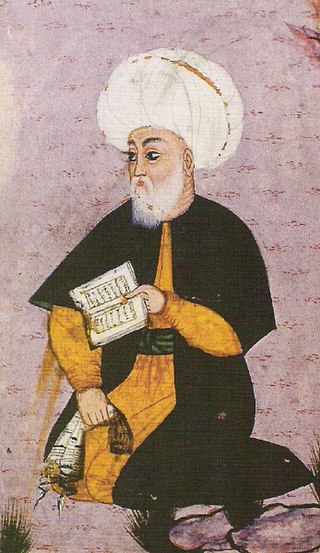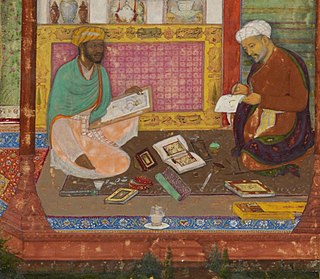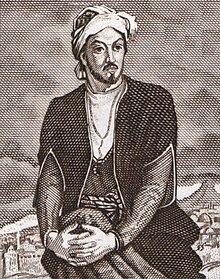
Azerbaijani literature is written in Azerbaijani, a Turkic language, which is the official state language of the Republic of Azerbaijan, where the North Azerbaijani variety is spoken. It is also natively spoken in Iran, where the South Azerbaijani variety is used, and is particularly spoken in the northwestern historic region of Azerbaijan. Azerbaijani is also spoken in Russia, Georgia and Turkey.

Hurufism was a Sufi movement based on the mysticism of letters (ḥurūf), which originated in Astrabad and spread to areas of western Iran (Persia) and Anatolia in the late 14th and early 15th centuries.

Muhammad bin Suleyman, better known by his pen name Fuzuli, was a 16th-century poet who composed works in his native Azerbaijani, as well as Persian and Arabic. He is regarded as one of the greatest poets of Turkic literature and a prominent figure in both Azerbaijani and Ottoman literature. Fuzuli's work was widely known and admired throughout the Turkic cultural landscape from the 16th to the 19th centuries, with his fame reaching as far as Central Asia and India.

In Islamic cultures of the Middle East, North Africa, Sicily and South Asia, a Diwan is a collection of poems by one author, usually excluding his or her long poems (mathnawī).
The culture of Azerbaijan combines a diverse and heterogeneous set of elements which developed under the influence of Iranic, Turkic and Caucasian cultures. Azerbaijani culture includes its distinct cuisine, literature, folk art, and music.

Fażlu l-Lāh Astar-Ābādī, also known as Fażlullāh Tabrīzī Astarābādī by a pseudonym al-Ḥurūfī and a pen name Nāimī, was an Iranian mystic who founded the Ḥurūfī movement. The basic belief of the Ḥurūfiyyah was that the God was incarnated in the body of Fażlullāh and that he would appear as Mahdī when the Last Day was near in order to save Muslims, Christians and Jews. His followers first came from the village of Toqchi near Isfahan and from there, the fame of his small community spread throughout Khorasan, Iraq, Azerbaijan and Shirvan. The center of Fażlullāh Nāimī's influence was Baku and most of his followers came from Shirvan. Among his followers was the famous Ḥurūfī poet Seyyed Imadaddin Nasimi, one of the greatest Turkic mystical poets of the late 14th and early 15th centuries.

The Nuqtavi movement was founded by Mahmoud Pasikhani when he proclaimed himself the Mahdi in 1397. The group is an offshoot of Hurufism, from which Pasīkhānī was expelled for arrogance. The group first arose in Anjudan near Kashan an area known for its Nizari Isma'ili Shia Islam. The group attempted to proclaim Tahmasp I as Mahdi after Pasikhani died.

Seyid Azim Shirvani was an Azerbaijani poet and enlightener. He got his first religious education in Iraq. After returning to motherland he refused his spiritual dignity and opened a private school. Seyid Azim Shirvani continued Fuzûlî’s traditions in his love-lyrical poems. In his satirical poems and fables Seyid Azim Shirvani ridiculed priesthood, opposed backwardness and ignorance, called to enlightenment and culture. Contemporary poets consider him their teacher.

Qāḍī Aḥmad Burhān al-Dīn was vizier to the Eretnid rulers of Anatolia. In 1381, he took over Eretnid lands and claimed the title of sultan for himself. He is most often referred to by the title Qadi, a name for Islamic judges, which was his first occupation.

Saib Tabrizi was an Iranian poet, regarded as one of the greatest masters of a form of classical Persian lyric poetry characterized by rhymed couplets, known as the ghazal. He also established the "Indian style" in the literature of his native language, Azerbaijani Turkic, in which he is known to have written 17 ghazals and molammaʿs.
Nationality words link to articles with information on the nation's poetry or literature.
Nationality words link to articles with information on the nation's poetry or literature.
Imad al-Din or Imad ad-Din, also Imad ud-din, is a male Muslim given name meaning "pillar of the religion, faith", composed from the nouns ‘imad, meaning pillar, and al-Din, of the faith.

Nesimi is an Azerbaijani biopic film shot in Baku, Absheron, Gobustan, Nakhichevan, Shamakhi (Azerbaijan), Bukhara, Samarkand (Uzbekistan), Halab, Damascus (Syria) in 1973. Screenplay was written by Isa Huseynov. Directed by Hasan Seyidbeyli, this film is in history drama genre depicting the life of a prominent Azerbaijani philosopher and poet, Imadaddin Nasimi. The film is considered one of the best Azerbaijani movies in historical genre produced during Soviet times. After this debut in a big movie, the actor in the leading role, Rasim Balayev became a notable actor after this movie.

Sheikh Izzeddin Esfarayeni, who wrote under the pseudonyms of Hasanoghlu and Pur-e Hasan, was a 13th and 14th century poet who wrote in Azerbaijani and Persian. He is the earliest known author of Azerbaijani literature.

Salman Mumtaz — Azerbaijani poet, literature historian, bibliographer, and collector of medieval manuscripts. He was a member of the Union of Azerbaijani writers since 1934, a researcher in the 1st category of the literature sector of the Azerbaijani Branch of the Academy of Sciences of the Soviet Union, and the director of the Azerbaijani Literature Department of the Azerbaijani National Institute of Scientific Research from 1929 to 1932. Salman Mumtaz was a renowned Azerbaijani literary scholar and poet. He was born in Shaki in 1884. In his efforts to collect, publish and promote the classical literary legacy, he discovered unknown manuscripts of a number of Azerbaijani poets and ashugs. Falling a victim to repressions, he was arrested in 1937 and killed by shooting in 1941 while imprisoned in Oryol.
Süruri (15th century, Aq Qoyunlu state) was an Azerbaijani poet who lived in the late 15th and early 16th centuries.
Habibi was a late 15th and early 16th century poet. He is regarded as the most important Azerbaijani poet of his generation.
Yusuf Meddah was an early 14th-century poet. He is considered one of the earliest known authors of Azerbaijani literature, and his poetry played a significant role in the development of the Azerbaijani literary language. Although little is known about his life, it is estimated that he lived at the beginning of the 14th century. Meddah was well-educated and fluent in Azerbaijani, Arabic, and Persian.
Nematullah Kishvari was a 15th- and 16th-century poet. He is considered one of the leading poets of Azerbaijani literature during that time and his poems played a significant role in the development of the Azerbaijani literary language.













